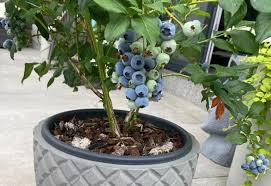Unlock the Joy of Growing Blueberries in Limited Spaces
Blueberries are beloved for their irresistible flavor and impressive nutritional benefits. Even if you’re short on garden space, you can enjoy the rewards of growing your own blueberries with container gardening. This guide will equip you with everything you need to know—from selecting the best varieties to caring for your plants—to ensure a bountiful harvest in compact spaces.
Choosing the Best Blueberry Varieties for Containers
Selecting the right blueberry variety is the cornerstone of successful container gardening. Here are some top choices:
- Lowbush Blueberries (Vaccinium angustifolium): Compact and low-growing, these are perfect for small containers and tight spaces.
- Half-High Blueberries: A cross between lowbush and highbush varieties, these medium-sized bushes adapt well to containers and yield delicious fruit.
- Dwarf Highbush Blueberries: Specifically designed for container cultivation, these plants are compact without sacrificing productivity.
- Rabbiteye Blueberries: While larger, they can still thrive in spacious pots if given proper care and room to grow.
Selecting the Right Container
Your choice of container is vital to your plant’s health and productivity. Consider these factors:
- Size: Use containers with at least 18 inches (45 cm) in diameter and depth to accommodate the plant’s extensive root system.
- Material: Durable options like plastic or ceramic are ideal. Ensure the container has sufficient drainage holes to prevent waterlogged soil.
- Soil: Blueberries require acidic soil with a pH of 4.5–5.5. Use a specialized potting mix for acid-loving plants or create your own blend with peat moss, pine bark, and perlite.

Planting Your Blueberries
Once your container and soil are ready, follow these steps:
- Timing: Plant in early spring or late fall when temperatures are mild.
- Spacing: If planting multiple bushes in a large container, leave at least 2 feet (60 cm) between plants.
- Depth: Ensure the hole in the soil is slightly deeper than the root ball.
- Fertilizer: Use a slow-release, acid-forming fertilizer sparingly or opt for organic alternatives.
Caring for Container Blueberries
Blueberries in containers require consistent attention to thrive. Here’s how to maintain them:
- Watering: Keep the soil evenly moist, especially during the growing season, but avoid waterlogging.
- Sunlight: Position your containers in a spot with 6–8 hours of direct sunlight daily. Use grow lights if natural sunlight is insufficient.
- Pruning: Prune annually in late winter to remove dead or weak branches, maintain shape, and encourage new growth.
- Mulching: Add mulch around the base of the plant to retain moisture, regulate soil temperature, and prevent weeds.
- Protection: Use bird netting or scare devices to protect ripening berries from birds.
- pH Monitoring: Test the soil regularly and make adjustments to maintain the ideal pH range.
Conclusion
Growing blueberries in containers is a gratifying way to enjoy fresh, homegrown fruit, even in small spaces. By selecting suitable varieties, choosing the right containers, and providing diligent care, you can cultivate thriving blueberry bushes that yield delicious harvests for years to come. Whether on a balcony, patio, or porch, container gardening allows you to unlock the full potential of this nutritious superfruit.
Happy gardening!
